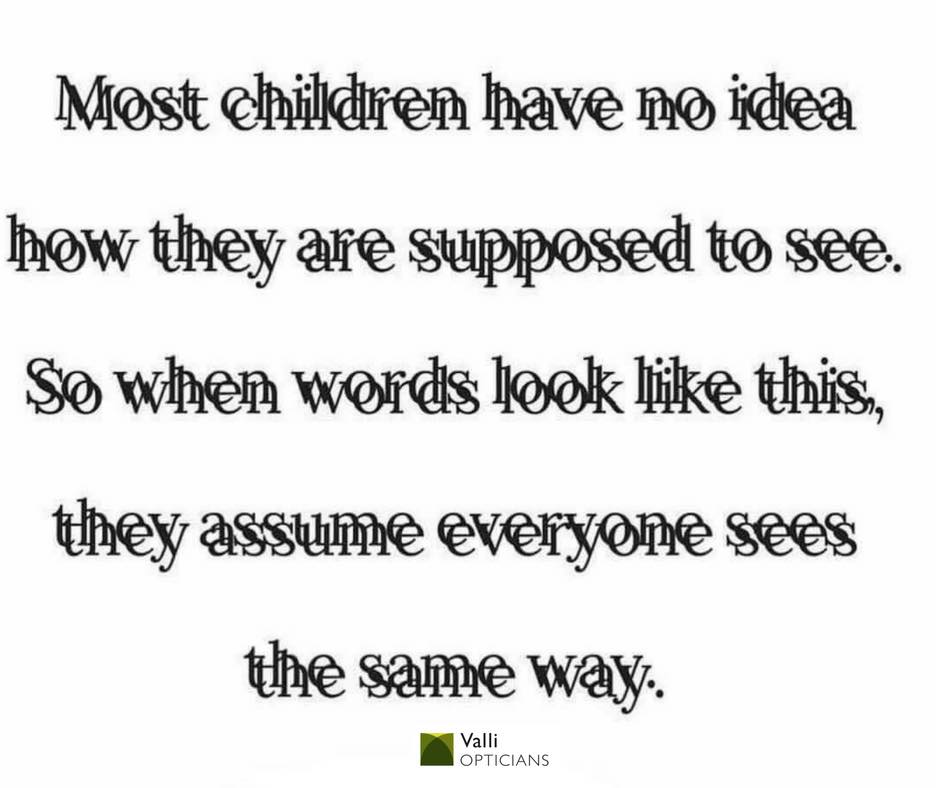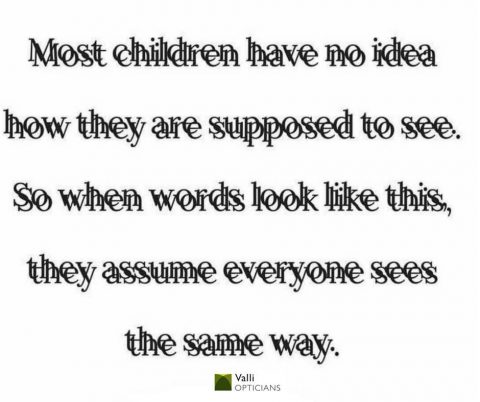What is Visual Stress?


![]() by Sarah Duckworth, Optometrist at Valli Opticians Honley/Meltham in Huddersfield
by Sarah Duckworth, Optometrist at Valli Opticians Honley/Meltham in Huddersfield
As a local optician I often see children and young people who have visual stress. They don’t realise that the reason they are struggling to read is because they have this condition. It’s more common than most people realise with some estimates stating it affects 1 in 10 people, so in a typical classroom that is around 2 to 3 children.
However it isn’t only children who can have visual stress; it can affect adults too.
The good news for those with visual stress is that there are measures we can take to relieve the symptoms and help the child or adult to read better.
Visual stress is also called Meares-Irlen Syndrome or Scotopic Sensitivity Syndrome.
Simply explained, Visual Stress is a sensitivity to visual patterns, particularly stripes. In some individuals this condition can cause visual perceptual problems, which interfere with reading. The symptoms can occur despite normal vision.
One current scientific explanation is that the perceptual problems are due to a hyperactivation of the visual cortex of the brain, particularly in more anterior visual areas, which is reduced by precise individual colour.
Symptoms most commonly arise when someone with the condition is trying to read paragraphs of black text on a white background. This light reflected back from the page contains all the wavelengths of light in the visual spectrum. In visual stress, the brain is unable to process the full spectral of light. Using colour (overlays or tinted lenses) will selectively reduce the input of certain wavelengths of light and allow the brain to process visual information correctly.
What are the symptoms of visual stress?
Usually the simplest questions are the best and I find that asking a child the following: “Are you good at reading?” often identifies those that may have visual stress. If a child is behind their peers in their reading ability, or below their expected level at school, it is strongly advisable to look at the possibility of visual stress.
The really common symptoms apart from this are losing the place on the page when reading or getting letters jumbled up which leads to misreading words or text moving on the page.
Frustration and low self-esteem can occur in children who are underachieving due to visual stress. Early diagnosis of the problem is therefore essential in my view. The longer it takes to identify and remedy visual stress, the greater the loss of confidence that can result.
As an exhaustive list, all or some of the following symptoms may be present:
- Words moving, blurring or going double
- Letters changing size or shape
- Patterns or halos of colour in text
- Red, sore, watery eyes
- Headaches when reading
Signs to look out for that may indicate visual stress:
- Misreading text or reading words in the wrong order
- Missing out words or whole lines of text
- Losing the place on a page when reading
- Tiring quickly when reading
- Moving closer to or further away from the book
- Moving the book around on the desk or fidgeting continuously
- Using a finger as a marker on the page
- Rubbing eyes or blinking frequently when reading
- Poor comprehension of reading content
Some people may have all these symptoms but often people only suffer with one or two. It’s also harder for children to describe their symptoms or for them to know that what they’re seeing isn’t normal.
What are the treatments?
Visual stress symptoms can be relieved with the help of coloured overlays or precision tinted lenses in spectacles.
When visual stress is suspected, a sight test is carried out followed by an Overlay Assessment where a variety of coloured overlays are shown to identify the colour which most reduces the visual stress symptoms..
A Wilkins Rate of Reading Test is then carried out to assess if the coloured overlay improves the reading ability. If there is an improvement, this chosen overlay colour is prescribed to be used for reading over the next four to six weeks.
If using the overlay significantly improves reading, the next test we recommend is an Intuitive Colorimetry Assessment’. This allows precision tinted lenses to be prescribed in glasses, which is much better and a lot more convenient to use compared to a coloured overlay.
At this appointment the optician will find the exact hue (colour) and saturation (darkness of colour) that helps relieve the visual stress symptoms. This piece of equipment is able to prescribe from up to 100,000 colour combinations. Spectacle lenses are then tinted in this exact colour and used not just for reading but also for looking at computer screens and whiteboards at school and college. These lenses can also help relieve migraines too!
Is visual stress the same as dyslexia?
No. Dyslexia is a learning difficulty which causes the person with the condition to have problems with reading, writing, spelling as well as other things. People with dyslexia often suffer from visual stress and will benefit from overlays or tinted lenses but people can have visual stress but not necessarily be dyslexic.
Here at Valli we can diagnose and treat visual stress but not dyslexia. If a patient is diagnosed with visual stress and is struggling in other areas than just reading we would advise a referral to an educational psychologist for a possible dyslexia diagnosis.
How successful is the use of colour?
What I have described has been used for a number of years and found to be very successful.
The degree of improvement for each person differs however: some people experience improvements in reading age of one to two years within a few weeks of acquiring the lenses. In others, the lenses may offer greater comfort when reading, but the reading improvement may be less dramatic because of other reading difficulties.